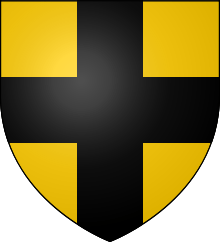John de Vesci
| John de Vesci | |
|---|---|
 Coat of arms of John de Vesci | |
| Spouse(s) |
1. Mary of Lusignan 2. Isabella de Beaumont |
| Noble family | de Vesci |
| Father | William de Vesci |
| Mother | Agnes de Ferrers |
| Buried | Alnwick Abbey |
John de Vesci, sometimes spelt Vescy, was a prominent 13th-century noble. He was the eldest son of William de Vesci and Agnes de Ferrers. He married firstly Mary of Lusignan and secondly Isabella de Beaumont. John died c. 1289.
He succeeded to his father's titles and estates upon his father's death in Gascony in 1253. These included the barony of Alnwick and a large property in Northumberland and considerable estates in Yorkshire, including Malton. Due to being under age, King Henry III of England conferred the wardship of John's estates to a foreign kinsmen, which caused great offence to the de Vesci family.
John sided with Simon de Montfort, 6th Earl of Leicester during the barons' rebellion against King Henry III, known as the Second Barons' War of 1263–64. He was summoned to the great parliament of January 1265, the first directly elected parliament in medieval Europe. During the battle of Evesham on 4 August 1265 he was wounded and taken prisoner. Released sometime afterwards he admitted to compound for his estates after the Dictum of Kenilworth.
During 1267, he participated with some of the northern barons in another rising, however Prince Edward went north with an army and John was forced to submit. After being treated well by Edward, he became a devoted friend. John went with Edward on his crusade to Palestine between 1271 and 1272. He was one of the two barons who led Eleanor of Castile from the presence of her husband Edward, when he was operated upon for his poisoned wound.
In 1273 he was made governor of Scarborough Castle. In 1275, John was part of an expedition against Guðrøðr Magnússon, who was leading an uprising on Mann, in an attempt to establish himself as king.[1] The Chronicle of Mann and Chronicle of Lanercost indicate that a Scottish fleet made landfall at Ronaldsway, on 7 October.[2] The Chronicle of Lanercost records that John de Vesci and other Scottish magnates arrayed their forces on St Michael's Isle, and sent forth an embassy offering Guðrøðr and his followers peace. Guðrøðr refused,[3] and the following morning, before sunrise, both chronicles indicate that his forces were utterly defeated during the battle of Ronaldsway.[2] According to the Chronicle of Mann, 537 rebels were slain by the Scots.[4]
John served in Wales in 1277. He married Mary of Lusignan in 1279, however Mary died very shortly afterwards. He married Isabella de Beaumont sometime afterwards and was granted by King Edward I of England lands in Northumberland and Kent, including Eltham.
He became the king's secretary and counsellor, and was sent in February 1282 with Antony Bek to Aragon to negotiate a marriage between Alfonso, son of King Peter III of Aragon, and Edward's daughter Eleanor, which resulted in the signing of the contract as proxy at Huesca. He served in Wales in 1282. In June 1285 he was sent with two others to negotiate the marriage between Edward's daughter Elizabeth and John, son of Floris V, Count of Holland.
John was given as a hostage by King Edward I to King James II of Aragon in 1288. He died in 1289, without issue, and was buried at Alnwick Abbey. His heart, was buried in 1290 with the hearts of Queen Eleanor and her eldest son, Alfonso, in the Dominican priory at Blackfriars. His brother William succeeded to his estates and his widow played a notable part in the reign of King Edward II of England, as a strong friend of the king and queen, procuring the advancement of her brothers.
Citations
- Footnotes
- ↑ McDonald 2007: pp. 54. See also: Sellar 2000: p. 210.
- 1 2 Anderson 1922: pp. 672–673. See also: Maxwell 1913: p. 11. See also: Munch; Goss 1874: pp. 110–111.
- ↑ Tout; Ridgeway 2004. See also: Anderson 1922: pp. 672–673. See also: Maxwell 1913: p. 11.
- ↑ Munch; Goss 1874: pp. 110–111.
References
- Primary sources
- Anderson, Alan Orr, ed. (1908), Scottish annals from English chroniclers, a.d. 500 to 1286, David Nutt.
- Anderson, Alan Orr, ed. (1922), Early sources of Scottish history: a.d. 500 to 1286, 2, Oliver and Boyd.
- Howlett, Richard, ed. (1895), Chronicles of the reigns of Stephen, Henry II., and Richard I., 2, Longman & Co.
- Maxwell, Herbert, ed. (1913), The chronicle of Lanercost, 1272-1346, James Maclehose and sons.
- Munch, Peter Andreas; Goss, Alexander, eds. (1874), Chronica regvm Manniæ et Insvlarvm: the chronicle of Man and the Sudreys; from the manuscript codex in the British Museum; with historical notes, 1, printed for the Manx Society.
- Secondary sources
- McDonald, Russell Andrew (2007), Manx kingship in its Irish sea setting, 1187–1229: king Rǫgnvaldr and the Crovan dynasty, Four Courts Press, ISBN 978-1-84682-047-2.
- Sellar, William David Hamilton (2000), "Hebridean sea kings: The successors of Somerled, 1164–1316", in Cowan, Edward J.; McDonald, Russell Andrew, Alba: Celtic Scotland in the middle ages, Tuckwell Press, pp. 187–218, ISBN 1-86232-151-5.
- Sellar, William David Hamilton (2004), "MacDougall, Alexander, lord of Argyll (d. 1310), magnate", Oxford Dictionary of National Biography ((subscription or UK public library membership required)), doi:10.1093/ref:odnb/49385, retrieved 5 July 2011.
- Tout, T. F.; Ridgeway, H. W. (2004), "Vescy, John de (1244–1289)", Oxford Dictionary of National Biography ((subscription or UK public library membership required)) (revised, online October 2005 ed.), doi:10.1093/ref:odnb/28254, retrieved 10 March 2012.
 This article incorporates text from a publication now in the public domain: "Vescy, John de". Dictionary of National Biography. London: Smith, Elder & Co. 1885–1900.
This article incorporates text from a publication now in the public domain: "Vescy, John de". Dictionary of National Biography. London: Smith, Elder & Co. 1885–1900.